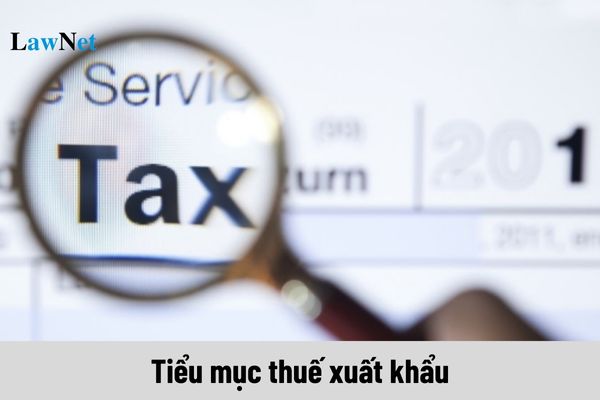What are the codes of sub-sections for export duty payment in Vietnam?
What are the codes of sub-sections for export duty payment in Vietnam?
According to Point b, Clause 1, Article 4 of Circular 324/2016/TT-BTC, the sub-section (also known as the economic content code - NDKT) is a detailed classification of the section, used to classify in detail the revenues and expenditures of the state budget according to management objects within each section.
Under Appendix 3 on the List of sections and sub-sections issued along with Circular 324/2016/TT-BTC, the sub-sections for export duty payment in 2024 are specified as follows:
| section code | sub-section code | Name | |
| section | 1850 | Export duty | |
| sub-section | 1851 | Export duty |
View detailed full chapter codes: Here

What are the codes of sub-sections for export duty payment in Vietnam? (Image from the Internet)
Which goods are subject to export duty in Vietnam?
According to Article 2 of the Law on Export and Import Duties 2016, the goods subject to export duty include:
- Goods exported through Vietnam’s border and border checkpoints.
- Goods exported from the domestic market into free trade zones; goods imported from free trade zones into the domestic market.
- Goods indirectly exported; goods exported by enterprises exercising their right to export, import, or distribute.
- The following goods do not incur export duty:
+ Goods in transit;
+ Goods that are humanitarian aid or grant aid;
+ Goods exported from a free trade zone to abroad; goods imported from abroad to a free trade zone and used within such free trade zone; goods transported from one free trade zone to another;
+ Amounts of petroleum used as severance tax paid to the State upon its exportation.
Which entities are required to pay the export duty in Vietnam?
According to Article 3 of the Law on Export and Import Duties 2016, export duty payers include:
- Owners of exports.
- Entrusted exporters.
- People entering and leaving Vietnam carrying exports, sending or receiving goods through Vietnam’s border and border checkpoints.
- Taxpayers’ guarantors and other entities authorized to pay tax on behalf of taxpayers, including:
+ Customs brokerage agents in case authorized by the taxpayer to pay export duty;
+ Providers of postal services or international express mail services paying tax on behalf of taxpayers;
+ Credit institutions or other organizations operating under the Law on credit institutions that provide guarantee or pay tax on behalf of taxpayers;
+ People authorized by goods owners in case goods are gifts of individuals; any luggage sent before or after its owner’s arrival or departure;
+ Any branch of an enterprise authorized to pay tax on its behalf;
+ Other people authorized to pay tax on behalf of taxpayers as prescribed by law.
- Any person who purchases or transports goods within the tax-free allowance applied to border residents which are sold domestically instead of being consumed or used for manufacture; foreign traders permitted to deal in exports at bordering markets as prescribed by law.
- Owners of exports that are initially tax-free but then taxed.
- Other cases prescribed by law.
What is the basis for calculating export duty in Vietnam?
According to Article 5 of the Law on Export and Import Duties 2016, the basis for calculating export duty is as follows:
- The amount of export duty is determined according to the taxable value and duty rate (%) of each article at the time of tax calculation.
The export duty rate of each article is specified in the export duty schedule.
Where goods are exported to a country or group of countries or territories having an agreement on concessional export duties with Vietnam, such agreement shall apply.
Additionally, the import duty rates include preferential rates, special preferential rates, and ordinary rates as follows:
+ Preferential rates apply to imports originated in any country or group of countries or territories that accord Vietnam most-favored nation treatment; goods that are imported from a free trade zone to the domestic market and originating in a country or group of countries or territories that accord Vietnam most-favored nation treatment;
+ Special preferential rates apply to imports originated in any country or group of countries or territories that have an agreement on special preferential import duties with Vietnam; goods that are imported from a free trade zone to the domestic market and originating in a country or group of countries or territories that have an agreement on special preferential import duties with Vietnam;
+ Ordinary rates apply to imports other than those mentioned in Point a and Point b of this Clause. The ordinary rate is 150% of the preferential rate applied to the corresponding article. In case preferential rate is 0%, the Prime Minister shall decide the application of ordinary rate pursuant to Article 10 of the Law on Export and Import Duties 2016.

